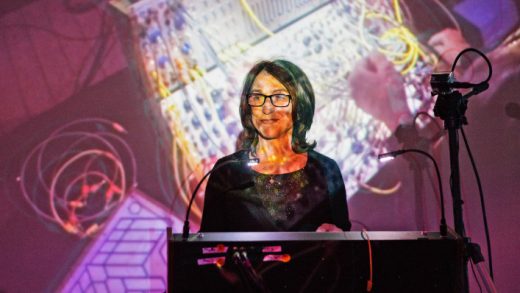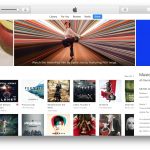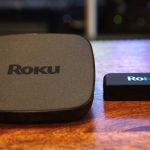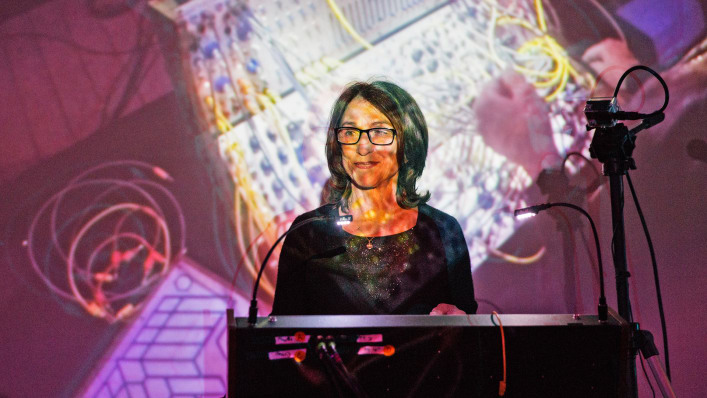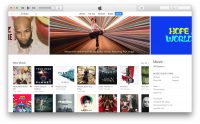Can Spatial 3D Audio Reinvent Live Music?
This concert sounds insane. It’s not just that the electronic, laser-like sounds coming from the modular synthesizer onstage recall an intergalactic battle from a sci-fi movie. It’s that they’re firing away all around me, bouncing from speaker to speaker inside the room. It sounds like I’m somehow in the music.
The performer is Suzanne Ciani, the electronic music pioneer and composer who was recently given the Moog Innovation Award at the Moogfest music and technology festival. This show is one of dozens of performances held during the four-day celebration, but it sounds different from the others. For many years, Ciani has performed using a quadrophonic sound system: a setup that uses four primary speakers placed in the corners of the venue, which allows the music to be split into four channels. The audio, not unlike that of a surround-sound home theater, can travel around you in a way that standard stereo systems can’t. One sound might come from behind you, while another chimes in from above or in front of you.
“People love quad,” Ciani tells me. “But it’s hard to get sometimes. You have to fight with the venue. You have to fight with the promoter.”
Her performance nearly didn’t happen as planned. But if anyone is going to be receptive to a sound-bending demand like this, it’s the Moogfest organizers. The daytime conference-style programming featured several workshops and discussions about three-dimensional spatial sound, an increasingly hot topic discussed at the bleeding edge of the music/tech nexus.
Why A Decades-Old Idea Is Coming Back
The resurgence of interest might seem odd, considering that spatial audio is hardly a new innovation. The quadrophonic version of immersive sound employed by Ciani has been around since the 1950s and peaked in the 1970s, after the format failed to gain much traction with consumers. In 1967, the famously experimental Pink Floyd played what is believed to be the first surround-sound rock concert using their own custom-built quadrophonic speaker system, the Azimuth Co-ordinator. Binaural recording, the process of capturing three-dimensional sound, had been in use for nearly a century when Lou Reed released the first binaurally recorded pop album, Street Hassle, in 1978. By then, attempts to release music on quadrophonic vinyl and other new multi-dimensional sound formats had largely been abandoned by the music industry, which opted to stick with stereo.
So why is spatial audio itching to make a comeback now? The shortest and most obvious answer: Technology. Back in the 1970s, capturing high-quality, three-dimensional audio was expensive and cumbersome for the music industry and for consumers to enjoy it would have necessitated costly home audio systems (or special headphones). At the time, it wasn’t clear that there would even be enough demand for spatial 3D audio to warrant the heavy investment required to produce and market it.
But technology, of course, tends to get smaller and cheaper as time marches on. Today, it’s easier to capture 3D audio and it’s even becoming easier to adapt older recordings to work in spatial formats. On the consumer side, the market is awash in relatively affordable home speaker systems that allow for surround sound, driven in part by the development of formats like DTS and Dolby 5.1 for movie theaters and home theater setups. Indeed, lots of albums get remixed in 5.1 surround sound for hardcore fans, like the recently reissued Beatles classic Sgt. Pepper’s Lonely Hearts Club Band.
This type of sound is slowly finding its way into concert venues as well. For now, electronic artists like Ciani have to demand it on their tech riders at shows (“If you say it is nonnegotiable, they will come around,” Ciani says), but the request may soon become easier to fulfill. In late April, musician Christopher Willits helped open Envelop, a venue in San Francisco with a 28.4 channel sound system that specializes in immersive 3D audio. The venue’s 28-speaker “Ambisonic” system has also been adapted to a mobile sound space called Envelop Satellite, which can be deployed at music festivals and other temporary locations.
Virtual Reality Pushes 3D Sound Forward
Virtual reality is another major factor behind the push toward spatial audio. As VR and augmented reality gradually creep into the mainstream, the immersive content created for these formats needs spatially rich, 3D audio.
In a rare display of early tech adoption, the music industry has embraced VR, eager to carve out its own slice of a market that’s expected to be worth $120 billion within a few years (and perhaps try to preempt another technology-driven disruption of the business). In the last six months, Universal Music and Warner Music have inked partnerships with MelodyVR to develop VR music content, and Viacom released what it calls the first-ever VR album. Virtual reality music videos and live concerts filmed in 360 degrees are becoming more common, even as VR headsets remain relatively rare in households. If the VR hype turns out to be a sustainable growth sector, though, the music industry will need to be prepared with material that sounds good in that world.
However the VR market plays out, the heightened investment seems to be driving renewed interest in spatial audio more generally. One of companies trying to push 3D sound forward is Sennheiser, the German microphone and speaker manufacturer that was an early pioneer in binaural recording. Sennheiser’s Ambeo sound format offers a 9.1 channel immersive 3D mix that can be used in home audio setups, theater sound systems, and even specialized headphones. An Ambeo remix of Pink Floyd’s “Comfortably Numb” was recently used in the new exhibit about the band at London’s Victoria and Albert Museum, where the song is played on 25 speakers, with different layers and details of the track coming from various directions in the room.
“With Ambeo, we try to create situations where there’s no difference between being there and not,” says Daniel Sennheiser, who runs the company along with his brother, Andreas. “If you close your eyes, your perception tells you its real.”
Very few of us will ever have museum-grade sound systems in our homes. But Sennheiser is working to make its Ambeo format more accessible to consumers and music engineers. Its Ambeo VR microphone is a $1,650 gadget that records high fidelity sound in three dimensions for use in VR and other immersive media. They also make Ambeo-enabled earbuds for the iPhone that allow for binaural 3D recording on the go.
The purpose of devices like these is to lower the barrier of entry for 3D recording so that sound designers, music producers, and consumers can become familiar with the concept. As awe-inspiring as the Pink Floyd Ambeo remix may be for fans of the band, not every artist has the means to have their work remixed at Abbey Road Studios by world-class engineers, which was the case with “Comfortably Numb.” To help nudge things along, Sennheiser published instructional blueprints for audio engineers looking to dabble in spatial audio. The hope is that, in the future, music will be recorded in a more 3D-friendly format so that intensive and costly remixing projects won’t be necessary.
For Sennhesier, getting their 3D sound into public installations is a way of marketing the idea to people who otherwise may not realize this technology exists.
“One of the difficult parts of this is that you have to let people experience it to really understand it,” says Andreas Sennheiser. “It’s like a great bottle of wine. To get somebody from buying a $5 bottle to a $15 bottle, you have to invite them to taste. That’s what we’re after.”
The hope for Sennheiser and others toying with 3D sound is that in time, the technology becomes more commonplace. Its adoption requires costly hardware and engineering that smaller venues may not be able to afford–and to be sure, not all music would necessarily sound great in 3D–but if widely implemented, the experience could enhance live music just enough to attract more people and bump up ticket prices.
Immersive audio can also be used in live broadcast scenarios to effectively increase the size of the audience for big shows. The Pink Floyd Ambeo installation at the V&A Museum certainly mimics the experience of being at a concert, both with sound and imagery. The next time Adele tickets go on sale and invariably sell out in minutes, promoters may well consider holding a satellite viewing of the show shot in 360 degrees and mixed in 3D to open up the event to people who couldn’t get tickets to the actual show. With more and more money being poured into creating live music VR content, there’s no reason that those virtual concerts need to stay crammed inside an Oculus Rift.
Evolving tech and the rise of virtual reality are finally making 3D audio a reality. It might even change the way you experience concerts.
This concert sounds insane. It’s not just that the electronic, laser-like sounds coming from the modular synthesizer onstage recall an intergalactic battle from a sci-fi movie. It’s that they’re firing away all around me, bouncing from speaker to speaker inside the room. It sounds like I’m somehow in the music.
Fast Company , Read Full Story
(67)

